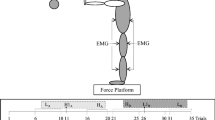Abstract.
The framework of the equilibrium-point hypothesis was used to reconstruct equilibrium trajectories (ETs) of the ankle, hip and body center of mass during quick voluntary hip flexions (`Japanese courtesy bow') by standing subjects. Different spring loads applied to the subject's back were used to introduce smooth perturbations that are necessary to reconstruct ETs based on a series of trials at the same task. Time patterns of muscle torques were calculated using inverse dynamics techniques. A second-order linear model was employed to calculate the instantaneous position of the spring-like joint or center of mass characteristic at different times during the movement. ETs of the joints and of the center of mass had significantly different shapes from the actual trajectories. Integral measures of electromyographic bursts of activity in postural muscles demonstrated a relation to muscle length corresponding to the equilibrium-point hypothesis.
Similar content being viewed by others
Author information
Authors and Affiliations
Additional information
Received: 3 March 1997 / Accepted in revised form: 2 November 1998
Rights and permissions
About this article
Cite this article
Domen, K., Latash, M. & Zatsiorsky, V. Reconstruction of equilibrium trajectories during whole-body movements. Biol Cybern 80, 195–204 (1999). https://doi.org/10.1007/s004220050517
Issue Date:
DOI: https://doi.org/10.1007/s004220050517




